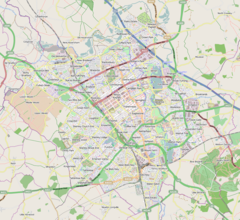가이아나의 경제
Economy of Guyana이 기사는 검증을 위해 추가적인 인용이 필요합니다. 찾기 – · · 책 · (2022년 12월)(이 를 및 |
 가이아나 조지타운 다운타운 | |
| 통화 | 가이아나 달러(GYD) |
|---|---|
| 역년 | |
무역기구 | CARICOM, WTO, Prosur, Unasur, Mercosur (관련) |
국가군 | |
| 통계 | |
| 인구. | |
| 국내총생산 |
|
| GDP 순위 | |
국내총생산 성장 | |
1인당 국내총생산 | |
1인당 GDP 순위 | |
부문별 GDP | |
| 6.0% (2023 추정) | |
빈곤선 이하 인구 | 35% (2006년 추산)[3] |
| 44.6 중 (2007)[3] | |
| |
노동력 | |
직업별노동력 | 해당 없음 |
| 실업률 | |
| 외부의 | |
| 수출품 | 57억 2100만 |
수출물품 | 원유, 설탕, 금, 보크사이트, 알루미나, 쌀, 새우, 당밀, 럼주, 목재, 철도 운송 컨테이너 |
주요 수출 상대국 | |
| 수입품 | 66억 6100만 |
수입물품 | 부유식 시추 플랫폼, 정제 석유, 밸브, 건설 차량, 자동차 제조, 기계, 식품 |
주요 수입 상대국 | [3] |
| 공공재정 | |
| -5.3%(2020년)[citation needed] | |
| 매출액 | 10억 2천만 (2017년)[3] |
| 경비 | 1. 164억 (2017) |
| 경제원조 | 580만 달러 (2020년)[12] |
| 해당 없음 | |
별도의 언급이 없는 한 모든 값은 미국 달러로 표시됩니다. | |

가이아나의 경제는 2021년 국내총생산(GDP) 성장률이 19.9%로 세계에서 가장 빠르게 성장하는 국가 중 하나입니다.[13]2023년 가이아나의 1인당 국내총생산(구매력 평가)은 INT $60,648이며 지난 10년간 평균 GDP 성장률은 4.2%였습니다.[4]가이아나의 경제는 2015년 조지타운에서 약 120마일 떨어진 이 나라 바다에서 근해 유전이 발견되면서 변화했습니다.2019년 12월 상업용 1등급 원유 추첨,[13] 정제용 해외 송출
개요
세계은행과 국제통화기금(IMF)과 함께 개발된 경제회복 프로그램은 경제에서 정부의 역할을 현저히 감소시키고, 외국인 투자를 장려하며, 정부가 외국 정부와 다자간 은행들에 대한 대출 상환에 대한 모든 연체를 청산할 수 있게 해주었습니다.그리고 41개의 정부 소유 (기생충) 사업체 중 15개의 매각을 가져왔습니다.휴대전화 회사와 목재, 쌀, 어업의 자산도 민영화되었습니다.거대 국영 설탕 회사인 가이수코와 가장 중요한 국영 보크사이트 광산을 관리하기 위해 국제적인 회사들이 고용되었습니다.한 미국 회사는 보크사이트 광산을 개장하는 것이 허락되었고, 두 개의 캐나다 회사는 남미에서 가장 큰 노천 광산을 개발하는 것이 허락되었습니다.하지만, 두 국영 보크사이트 광산 회사인 버비스 광산 회사와 린덴 광산 회사를 민영화하려는 노력은 지금까지 성공적이지 못했습니다.
대부분의 가격 통제를 없애고, 광업과 석유 탐사에 영향을 미치는 법을 개선했으며, 외국인 투자를 수용하는 투자 정책을 발표했습니다.민간 부문의 수출과 농업 생산을 촉진하기 위한 세제 개혁이 시행되었습니다.
부채
1986년 이래로 가이아나는 PL 480 Food for Peace 프로그램에 따라 미국으로부터 밀 전량을 양허 조건으로 공급받고 있습니다.지금은 보조금으로 공급되고 있습니다.밀 판매로 만들어진 가이아나 통화는 미국과 가이아나 정부가 합의한 목적으로 사용됩니다.많은 개발도상국들과 마찬가지로 가이아나도 부채가 많습니다.부채 부담을 줄이는 것이 현 정부의 최우선 과제 중 하나였습니다.1999년 파리 클럽 "라이옹 조건"과 부채가 많은 가난한 나라들(HIPC) 계획을 통해 가이아나는 2억 5천 6백만 달러의 채무 탕감 협상에 성공했습니다.
HIPC 지원 자격을 얻기 위해 가이아나는 처음으로 다자간 채무를 줄일 수 있는 자격을 얻었습니다.가이아나 부채의 약 절반은 다자간 개발 은행에, 20%는 1986년까지 석유 제품의 주요 공급처였던 이웃 트리니다드 토바고에 부채가 있습니다.미국 정부에 대한 거의 모든 빚이 탕감됐습니다.1999년 말 순 국제 준비금은 1억2320만 달러로 1994년의 2억5400만 달러에 비해 감소했습니다.그러나, 순 국제 보유고는 2001년 1월까지 1억 7천 410만 달러로 반등했습니다.
가이아나는 외국 채권자들에 대한 극도의 부채 부담으로 인해 외환 가용성이 제한되고 필요한 원자재, 예비 부품 및 장비를 수입할 수 있는 능력이 줄어들어 생산이 더욱 감소했습니다.전 세계적인 연료비 상승도 한국의 생산 감소와 무역 적자 증가의 원인이 되었습니다.생산 감소로 실업률이 높아졌습니다.신뢰할 만한 통계는 존재하지 않지만, 실업과 불완전 고용을 합친 것은 약 30%로 추정됩니다.
주로 미국과 캐나다로의 이민은 여전히 상당한 규모를 유지하고 있습니다.1998년의 순 이민은 인구의 약 1.4 퍼센트로 추정되었고, 1999년에는 이 수치가 총 1.2 퍼센트였습니다.수년간 국가 주도의 경제 체제를 거친 후에도, 국내외를 막론하고 민간 투자의 메커니즘은 여전히 진화하고 있습니다.국가 통제 경제에서 주로 혼합 경제 체제로의 전환은 Desmond Hoyte 하에서 시작되었고 PPP/CIVIC 정부 하에서 계속되었습니다.현 PPP/C 정부는 일자리 창출, 기술력 향상, 수출상품 창출을 위한 외국인 투자의 필요성을 인식하고 있습니다.
외환시장은 1991년에 완전히 자유화되었고, 현재는 자유롭게 화폐를 거래할 수 있습니다.환율은 매일 변경될 수 있지만 가이아나 달러는 1998년부터 2000년까지 17.6% 하락했으며 선거 후 기간이 안정될 때까지 더 하락할 수 있습니다.
경제사
유럽 정착 및 농장 노동자
네덜란드인들은 1600년대에 가이아나에 처음으로 정착하여 아메리카인들과 교역을 하고 농장을 설립했습니다.곧 토양과 기후가 사탕수수를 재배하기에 이상적이라는 것을 알게 되었고 아프리카의 노예들이 이 농장에서 일하기 위해 끌려왔습니다.기아나의 식민지들은 합병되어 대영제국으로 넘어갔습니다.노예제가 폐지되었을 때, 인도로부터 계약직 하인으로서 새로운 노동의 물결이 들어왔습니다.정치는 강력한 농장주들에 의해 크게 통제되었습니다.포르투갈인들과 중국인들도 농업 노동으로 입국했지만, 결국 그들 자신의 특정 서비스 산업에 정착했습니다.[14]
국유화
가이아나가 영국의 지배로부터 독립했을 때, 수 세기 동안 외국의 개입 후에 경제가 현지에서 소유되도록 보장할 필요성이 컸습니다.당시 사회주의 정책은 큰 관심사였고, 1970년대 번햄 대통령 재임 기간에 빈곤층과 노동자 계층을 지원하기 위해 새로운 기관을 설립하는 등 산업의 모든 부문이 초기에 국유화되었습니다.처음에 정부 투자는 성장을 돕는 데 성공했지만, 관리 기술이 부족했고 세계 상품 가격과 경쟁에 직면해 약했습니다.경제적인 갈등과 정치적인 갈등이 함께 진행되었고, 그로 인한 이민의 물결로 인구가 감소했습니다.[15]
시장개방
호이트 대통령의 1989년 경제 회복 프로그램 이후 경제는 극적인 진전을 이루었습니다.그 결과 가이아나의 GDP는 15년 만인 1991년 6% 증가했습니다.1995년 5.1%로 하락하기 전까지 지속적으로 성장률이 6%를 넘었습니다.정부는 경제가 1996년 7.9%, 1997년 6.2%의 성장률을 보였고 1998년에는 1.3% 하락했다고 보고했습니다.1999년의 성장률은 3퍼센트였습니다.2005년 비공식 성장률은 0.5%였습니다.2006년에는 3.2%였습니다.
사회 기반 시설
주로 해안가에 기반시설이 집중되어 있고, 접근성과 에너지의 한계로 배후산업을 구축하는 데 어려움이 있습니다.
주요 경제부문
농업과 광업은 가이아나의 가장 중요한 경제 활동이며, 설탕, 보크사이트, 쌀, 금이 수출 수입의 70-75%를 차지합니다.그러나, 쌀 부문은 2000년에 감소를 경험했고, 2000년 3분기까지 수출 실적이 27% 감소했습니다.1999년 한 달간의 미국 수입 금지 조치의 영향을 많이 받았던 원양 새우 수출은 그 해 전체 수출 수입의 3.5%에 불과했습니다.새우 수출은 2000년에 반등하여 2000년 3분기까지 수출 실적의 11%를 차지했습니다.다른 수출품으로는 목재, 다이아몬드, 의류, 럼주, 의약품 등이 있습니다.이러한 다른 수출품들의 가치는 증가하고 있습니다.
농업
설탕은 가이아나의 역사적으로 가장 중요한 상품이지만, 세계적인 경쟁과 다른 요인들로 인해 산업이 쇠퇴하고 있습니다.관련 제품인 당밀, 럼과 함께 여전히 주요 수출품입니다.[16]뱅크스 DIH와 데메라라 증류소는 이 나라의 유일한 증류소이지만 가이아나는 세계 14위의 럼주 수출국입니다.[17]
2018년 가이아나는 사탕수수 120만 톤, 쌀 96만 4천 톤, 코코넛 13만 6천 톤을 생산했으며, 이외에도 가지(47천 톤), 파인애플(34천 톤), 후추(37천 톤), 바나나(23천 톤), 오렌지(21천 톤), 카사바(20) 등의 농산물 생산 규모도 작았습니다.천 톤) 등.[18]
채광
최근 몇 년간 가이아나 국내총생산(GDP)의 상당 부분을 차지하며 설탕의 경제적 중요성을 뛰어넘어 광업이 이루어지고 있습니다.대규모 금광과 보크사이트 채굴 작업은 모두 외국인 소유이지만 금광과 다이아몬드 채굴의 방대한 비중은 중소 광부들이 맡고 있습니다.
석유
2010년대 들어 엑손사의 중요한 역외 석유 발견으로 인해 외국인 투자에 대한 관심이 다시 높아졌습니다.2018년 추산에 따르면 가이아나의 유전은 32억 배럴 이상을 보유하고 있습니다.[16]해상 원유 추출은 2019년에 시작되었습니다.
임업
가이아나는 "대륙에서 가장 큰 오염되지 않은 열대 우림"을 포함하고 있습니다.[16]전국을 뒤덮고 있는 광대한 숲에도 불구하고, 목재 산업은 도로가 개발되지 않았고 제분 작업을 위한 전기가 부족하거나 신뢰할 수 없는 등의 인프라적인 한계로 인해 소규모로 남아있었습니다.[19]
이 나라는 또한 숲을 보호하기 위해 노력하는 국제 단체들로부터 많은 재정적 기부를 받고 있습니다.
낚시
어획물의 대부분은 현지에서 소비되지만, 바다 새우의 수출 시장은 상당히 넓습니다.새우의 남획으로 대서양 바다 밥은 상업적으로 가장 중요한 어획물이 되었습니다.상업적 어업은 대부분 해양 어업이며, 내륙 어업은 주로 아메리카 인디언들이 하는 자급자족 어업에 기인합니다.[20]
데이터.
다음 표는 1980-2028년 주요 경제 지표(2021-2028년 IMF 직원 추정치 포함)를 보여줍니다.3% 미만의 인플레이션은 녹색입니다.[21]
| 연도 | 국내총생산 (빌에서).US$PPP) | 1인당 국내총생산 (US$PPP) | 국내총생산 (빌에서).US$공칭) | 1인당 국내총생산 (US$ 공칭) | 국내총생산 성장 (진짜) | 물가상승률 (%) | 실업률 (%) | 국채 (국내총생산(GDP) 대비 %) |
|---|---|---|---|---|---|---|---|---|
| 1980 | 7.1% | n/a | ||||||
| 1981 | n/a | |||||||
| 1982 | n/a | |||||||
| 1983 | n/a | |||||||
| 1984 | n/a | |||||||
| 1985 | n/a | |||||||
| 1986 | n/a | |||||||
| 1987 | n/a | |||||||
| 1988 | n/a | |||||||
| 1989 | n/a | |||||||
| 1990 | n/a | |||||||
| 1991 | n/a | |||||||
| 1992 | n/a | |||||||
| 1993 | n/a | |||||||
| 1994 | n/a | |||||||
| 1995 | n/a | |||||||
| 1996 | n/a | |||||||
| 1997 | 101.4% | |||||||
| 1998 | ||||||||
| 1999 | ||||||||
| 2000 | ||||||||
| 2001 | 2.3% | |||||||
| 2002 | ||||||||
| 2003 | ||||||||
| 2004 | ||||||||
| 2005 | ||||||||
| 2006 | ||||||||
| 2007 | ||||||||
| 2008 | ||||||||
| 2009 | ||||||||
| 2010 | ||||||||
| 2011 | ||||||||
| 2012 | ||||||||
| 2013 | ||||||||
| 2014 | ||||||||
| 2015 | ||||||||
| 2016 | ||||||||
| 2017 | ||||||||
| 2018 | ||||||||
| 2019 | ||||||||
| 2020 | ||||||||
| 2021 | ||||||||
| 2022 | ||||||||
| 2023 | ||||||||
| 2024 | ||||||||
| 2025 | ||||||||
| 2026 | ||||||||
| 2027 | ||||||||
| 2028 |
참고 항목
참고문헌
- ^ "World Economic Outlook Database, April 2019". IMF.org. International Monetary Fund. Retrieved 29 September 2019.
- ^ "World Bank Country and Lending Groups". datahelpdesk.worldbank.org. World Bank. Retrieved 29 September 2019.
- ^ a b c d e f g h i j k l m "The World Factbook". CIA.gov. Central Intelligence Agency. Retrieved 10 February 2019.
- ^ a b c d e "Report for Selected Countries and Subjects: April 2023". imf.org. International Monetary Fund.
- ^ a b c d "The outlook is uncertain again amid financial sector turmoil, high inflation, ongoing effects of Russia's invasion of Ukraine, and three years of COVID". International Monetary Fund. April 11, 2023.
- ^ "World Economic Outlook Database, April 2020". IMF.org. International Monetary Fund. Retrieved 21 November 2022.
- ^ "Human Development Index (HDI)". hdr.undp.org. HDRO (Human Development Report Office) United Nations Development Programme. Retrieved 21 November 2022.
- ^ "Inequality-adjusted Human Development Index (IHDI)". hdr.undp.org. HDRO (Human Development Report Office) United Nations Development Programme. Retrieved 21 November 2022.
- ^ "Labor force, total - Guyana". data.worldbank.org. World Bank. Retrieved 11 September 2022.
- ^ "Employment to population ratio, 15+, total (%) (national estimate) - Guyana". data.worldbank.org. World Bank. Retrieved 11 September 2022.
- ^ "Ease of Doing Business in Guyana". Doingbusiness.org. Retrieved 2017-01-23.
- ^ "Net official development assistance and official aid received (current US$) – Guyana". OECD. Retrieved September 12, 2022.
- ^ a b "The Five Fastest Growing Economies in the World, October 2020". Nasdaq.com. Nasdaq. Retrieved 14 December 2020.
- ^ "Guyana - HISTORY OF THE ECONOMY". countrystudies.us. Retrieved 2020-12-04.
- ^ "Guyana - HISTORY OF THE ECONOMY - Postindependence". countrystudies.us. Retrieved 2020-12-04.
- ^ a b c "South America :: Guyana — The World Factbook - Central Intelligence Agency". www.cia.gov. Retrieved 2020-12-04.
- ^ "Guyana's Rum Industry on an economic high". Guyana Chronicle. Retrieved 2021-01-20.
- ^ 2018년 가이아나 생산(FAO)
- ^ "Guyana - Forestry". countrystudies.us. Retrieved 2020-12-04.
- ^ "FAO Fisheries & Aquaculture - Country Profile". www.fao.org. Retrieved 2020-12-04.
- ^ "Report for Selected Countries and Subjects". International Monetary Fund (IMF). Retrieved 2023-05-23.




